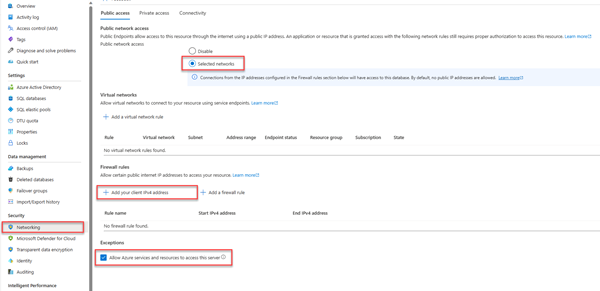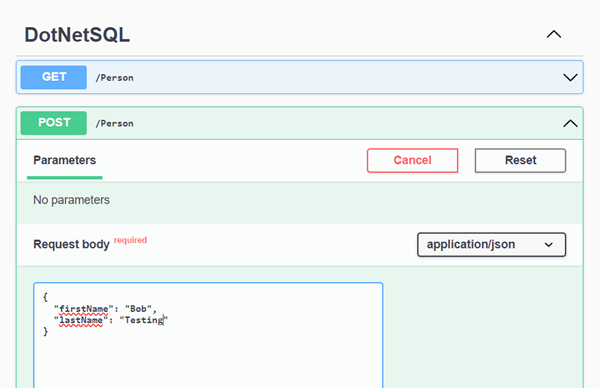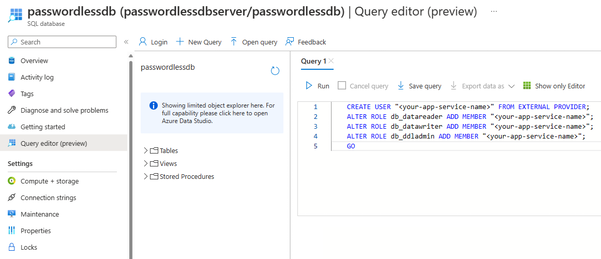Connect to and query Azure SQL Database using .NET and Entity Framework Core
Applies to:
Azure SQL Database
This quickstart describes how to connect an application to a database in Azure SQL Database and perform queries using .NET and Entity Framework Core. This quickstart follows the recommended passwordless approach to connect to the database. You can learn more about passwordless connections on the passwordless hub.
Prerequisites
- An Azure subscription.
- A SQL database configured for authentication with Microsoft Entra ID (formerly Azure Active Directory). You can create one using the Create database quickstart.
- .NET 7.0 or later.
- Visual Studio or later with the ASP.NET and web development workload.
- The latest version of the Azure CLI.
- The latest version of the Entity Framework Core tools:
- Visual Studio users should install the Package Manager Console tools for Entity Framework Core.
- .NET CLI users should install the .NET CLI tools for Entity Framework Core.
Configure the database server
Secure, passwordless connections to Azure SQL Database require certain database configurations. Verify the following settings on your logical server in Azure to properly connect to Azure SQL Database in both local and hosted environments:
For local development connections, make sure your logical server is configured to allow your local machine IP address and other Azure services to connect:
Navigate to the Networking page of your server.
Toggle the Selected networks radio button to show additional configuration options.
Select Add your client IPv4 address(xx.xx.xx.xx) to add a firewall rule that will enable connections from your local machine IPv4 address. Alternatively, you can also select + Add a firewall rule to enter a specific IP address of your choice.
Make sure the Allow Azure services and resources to access this server checkbox is selected.
Warning
Enabling the Allow Azure services and resources to access this server setting is not a recommended security practice for production scenarios. Real applications should implement more secure approaches, such as stronger firewall restrictions or virtual network configurations.
You can read more about database security configurations on the following resources:
The server must also have Microsoft Entra authentication enabled and have a Microsoft Entra admin account assigned. For local development connections, the Microsoft Entra admin account should be an account you can also log into Visual Studio or the Azure CLI with locally. You can verify whether your server has Microsoft Entra authentication enabled on the Microsoft Entra ID page of your logical server.
If you're using a personal Azure account, make sure you have Microsoft Entra setup and configured for Azure SQL Database in order to assign your account as a server admin. If you're using a corporate account, Microsoft Entra ID will most likely already be configured for you.
Create the project
The steps in this section create a .NET Minimal Web API by using either the .NET CLI or Visual Studio 2022.
In the Visual Studio menu bar, navigate to File > New > Project...
In the dialog window, enter ASP.NET into the project template search box and select the ASP.NET Core Web API result. Choose Next at the bottom of the dialog.
For the Project Name, enter DotNetSQL. Leave the default values for the rest of the fields and select Next.
For the Framework, select .NET 7.0 and uncheck Use controllers (uncheck to use minimal APIs). This quickstart uses a Minimal API template to streamline endpoint creation and configuration.
Choose Create. The new project opens inside the Visual Studio environment.
Add Entity Framework Core to the project
To connect to Azure SQL Database by using .NET and Entity Framework Core you need to add three NuGet packages to your project using one of the following methods:
In the Solution Explorer window, right-click the project's Dependencies node and select Manage NuGet Packages.
In the resulting window, search for EntityFrameworkCore. Locate and install the following packages:
- Microsoft.EntityFrameworkCore: Provides essential Entity Framework Core functionality
- Microsoft.EntityFrameworkCore.SqlServer: Provides additional components to connect to the logical server
- Microsoft.EntityFrameworkCore.Design: Provides support for running Entity Framework migrations
Alternatively, you can also run the Install-Package cmdlet in the Package Manager Console window:
Install-Package Microsoft.EntityFrameworkCore
Install-Package Microsoft.EntityFrameworkCore.SqlServer
Install-Package Microsoft.EntityFrameworkCore.Design
Add the code to connect to Azure SQL Database
The Entity Framework Core libraries rely on the Microsoft.Data.SqlClient and Azure.Identity libraries to implement passwordless connections to Azure SQL Database. The Azure.Identity library provides a class called DefaultAzureCredential that handles passwordless authentication to Azure.
DefaultAzureCredential supports multiple authentication methods and determines which to use at runtime. This approach enables your app to use different authentication methods in different environments (local vs. production) without implementing environment-specific code. The Azure Identity library overview explains the order and locations in which DefaultAzureCredential looks for credentials.
Complete the following steps to connect to Azure SQL Database using Entity Framework Core and the underlying DefaultAzureCredential class:
Add a
ConnectionStringssection to theappsettings.Development.jsonfile so that it matches the following code. Remember to update the<your database-server-name>and<your-database-name>placeholders.The passwordless connection string includes a configuration value of
Authentication=Active Directory Default, which enables Entity Framework Core to useDefaultAzureCredentialto connect to Azure services. When the app runs locally, it authenticates with the user you're signed into Visual Studio with. Once the app deploys to Azure, the same code discovers and applies the managed identity that is associated with the hosted app, which you'll configure later.Note
Passwordless connection strings are safe to commit to source control, since they do not contain any secrets such as usernames, passwords, or access keys.
{ "Logging": { "LogLevel": { "Default": "Information", "Microsoft.AspNetCore": "Warning" } }, "ConnectionStrings": { "AZURE_SQL_CONNECTIONSTRING": "Data Source=passwordlessdbserver.database.windows.net; Initial Catalog=passwordlessdb; Authentication=Active Directory Default; Encrypt=True;" } }Add the following code to the
Program.csfile above the line of code that readsvar app = builder.Build();. This code performs the following configurations:Retrieves the passwordless database connection string from the
appsettings.Development.jsonfile for local development, or from the environment variables for hosted production scenarios.Registers the Entity Framework Core
DbContextclass with the .NET dependency injection container.var connection = String.Empty; if (builder.Environment.IsDevelopment()) { builder.Configuration.AddEnvironmentVariables().AddJsonFile("appsettings.Development.json"); connection = builder.Configuration.GetConnectionString("AZURE_SQL_CONNECTIONSTRING"); } else { connection = Environment.GetEnvironmentVariable("AZURE_SQL_CONNECTIONSTRING"); } builder.Services.AddDbContext<PersonDbContext>(options => options.UseSqlServer(connection));
Add the following endpoints to the bottom of the
Program.csfile aboveapp.Run()to retrieve and add entities in the database using thePersonDbContextclass.app.MapGet("/Person", (PersonDbContext context) => { return context.Person.ToList(); }) .WithName("GetPersons") .WithOpenApi(); app.MapPost("/Person", (Person person, PersonDbContext context) => { context.Add(person); context.SaveChanges(); }) .WithName("CreatePerson") .WithOpenApi();Finally, add the
PersonandPersonDbContextclasses to the bottom of theProgram.csfile. The Person class represents a single record in the database'sPersonstable. ThePersonDbContextclass represents the Person database and allows you to perform operations on it through code. You can read more aboutDbContextin the Getting Started documentation for Entity Framework Core.public class Person { public int Id { get; set; } public string FirstName { get; set; } public string LastName { get; set; } } public class PersonDbContext : DbContext { public PersonDbContext(DbContextOptions<PersonDbContext> options) : base(options) { } public DbSet<Person> Person { get; set; } }
Run the migrations to create the database
To update the database schema to match your data model using Entity Framework Core you must use a migration. Migrations can create and incrementally update a database schema to keep it in sync with your application's data model. You can learn more about this pattern in the migrations overview.
Open a terminal window to the root of your project.
Run the following command to generate an initial migration that can create the database:
Add-Migration InitialCreateA
Migrationsfolder should appear in your project directory, along with a file calledInitialCreatewith unique numbers prepended. Run the migration to create the database using the following command:Update-DatabaseThe Entity Framework Core tooling will create the database schema in Azure defined by the
PersonDbContextclass.
Test the app locally
The app is ready to be tested locally. Make sure you're signed in to Visual Studio or the Azure CLI with the same account you set as the admin for your database.
Press the run button at the top of Visual Studio to launch the API project.
On the Swagger UI page, expand the POST method and select Try it.
Modify the sample JSON to include values for the first and last name. Select Execute to add a new record to the database. The API returns a successful response.
Expand the GET method on the Swagger UI page and select Try it. Select Execute, and the person you just created is returned.
Deploy to Azure App Service
The app is ready to be deployed to Azure. Visual Studio can create an Azure App Service and deploy your application in a single workflow.
Make sure the app is stopped and builds successfully.
In Visual Studio's Solution Explorer window, right-click on the top-level project node and select Publish.
In the publishing dialog, select Azure as the deployment target, and then select Next.
For the specific target, select Azure App Service (Windows), and then select Next.
Select the green + icon to create a new App Service to deploy to and enter the following values:
Name: Leave the default value.
Subscription name: Select the subscription to deploy to.
Resource group: Select New and create a new resource group called msdocs-dotnet-sql.
Hosting Plan: Select New to open the hosting plan dialog. Leave the default values and select OK.
Select Create to close the original dialog. Visual Studio creates the App Service resource in Azure.
Once the resource is created, make sure it's selected in the list of app services, and then select Next.
On the API Management step, select the Skip this step checkbox at the bottom and then select Finish.
Select Publish in the upper right of the publishing profile summary to deploy the app to Azure.
When the deployment finishes, Visual Studio launches the browser to display the hosted app, but at this point the app doesn't work correctly on Azure. You still need to configure the secure connection between the App Service and the SQL database to retrieve your data.
Connect the App Service to Azure SQL Database
The following steps are required to connect the App Service instance to Azure SQL Database:
- Create a managed identity for the App Service. The
Microsoft.Data.SqlClientlibrary included in your app will automatically discover the managed identity, just like it discovered your local Visual Studio user. - Create a SQL database user and associate it with the App Service managed identity.
- Assign SQL roles to the database user that allow for read, write, and potentially other permissions.
There are multiple tools available to implement these steps:
Service Connector is a tool that streamlines authenticated connections between different services in Azure. Service Connector currently supports connecting an App Service to a SQL database via the Azure CLI using the az webapp connection create sql command. This single command completes the three steps mentioned above for you.
az webapp connection create sql
-g <your-resource-group>
-n <your-app-service-name>
--tg <your-database-server-resource-group>
--server <your-database-server-name>
--database <your-database-name>
--system-identity
You can verify the changes made by Service Connector on the App Service settings.
Navigate to the Identity page for your App Service. Under the System assigned tab, the Status should be set to On. This value means that a system-assigned managed identity was enabled for your app.
Navigate to the Configuration page for your App Service. Under the Connection strings tab, you should see a connection string called AZURE_SQL_CONNECTIONSTRING. Select the Click to show value text to view the generated passwordless connection string. The name of this connection string aligns with the one you configured in your app, so it will be discovered automatically when running in Azure.
Important
Although this solution provides a simple approach for getting started, it is not a best practice for enterprise production environments. In those scenarios the app should not perform all operations using a single, elevated identity. You should try to implement the principle of least privilege by configuring multiple identities with specific permissions for specific tasks.
You can read more about configuring database roles and security on the following resources:
Test the deployed application
Browse to the URL of the app to test that the connection to Azure SQL Database is working. You can locate the URL of your app on the App Service overview page. Append the /person path to the end of the URL to browse to the same endpoint you tested locally.
The person you created locally should display in the browser. Congratulations! Your application is now connected to Azure SQL Database in both local and hosted environments.
Clean up the resources
When you are finished working with the Azure SQL Database, delete the resource to avoid unintended costs.
In the Azure portal search bar, search for Azure SQL and select the matching result.
Locate and select your database in the list of databases.
On the Overview page of your Azure SQL Database, select Delete.
On the Azure you sure you want to delete... page that opens, type the name of your database to confirm, and then select Delete.
Next steps
Feedback
Coming soon: Throughout 2024 we will be phasing out GitHub Issues as the feedback mechanism for content and replacing it with a new feedback system. For more information see: https://aka.ms/ContentUserFeedback.
Submit and view feedback for




